Brief:
- A majority of marketers (82%) plan to boost their use of location data over the next two years to seek greater insights into how consumers interact with businesses, according to a study conducted by 451 Research and commissioned by Cuebiq, who shared the results with Mobile Marketer.
- Three out of four (72%) respondents said knowing how customers spend time in the real world would be useful in planning marketing campaigns, while 65% said mapping the offline journey toward a purchase decision helps to understand customer behavior and brand affinity. About half (43%) of respondents want to use location data to send promotions to customers when they enter a specific geofence.
- The greatest challenge for marketers when it comes to location data is the lack of ability to measure success across channels, along with few financial resources and not have the technology to properly collect and analyze the data. The study was conducted in April among 150 North American marketers in the automotive, retail, quick-service restaurant and banking industries.
Insight:
The study suggests that while many marketers understand the promise of location data, figuring out how to efficiently gather and use this information is still difficult. Many marketers feel that they're on the cusp of discovering new uses for location intelligence, but don't fully know how to manage the transition while maintaining users' right to privacy.
Mobile location data offers the possibility to gather real-time information about consumers through their smartphone, rather than trying to infer attributes and behaviors from other sources like store data, census surveys and IP addresses. Regional census and point-of-sale data are the most common forms of location-oriented data, with 55% of marketers using each form, per the study.
Advertising remains the most significant uses of mobile-driven location intelligence, including the practice of "conquesting" — or sending McDonald's ads to people who walk into a Burger King, for example. Half of marketers surveyed said they deploy location data for this purpose, although there were several challenges. First, such campaigns often lacked scale, and in some cases, the need for scale to attract major advertisers resulted in ad networks building tech platforms that emphasized reach over accuracy. Mapping capabilities are improving and can identify more locations and more accurate boundaries than in the past, per Cuebiq.
Marketers could take more of an offensive approach and use location data for competitive intelligence and adjust their own strategies to get ahead of competitors in the industry. Cuebiq found that 77% of respondents said they expect to increase their use of location data for this purpose, while 71% expressed interest in competitive intelligence as a general use case.
Competitive intelligence can be used in a variety of ways to improve marketing strategy and boost customer loyalty. For example, an audience segment that visits a restaurant once a month may appear to be a loyal group that needs few, if any, discounts or offers to encourage repeat visits. However, if a large portion of those customers visits a competing eatery three times a month, that group could a key target for additional enticements. Loyalty programs most commonly dole out reward points based on purchases, but knowledge about what other services customers value could open the door to more effective programs.












